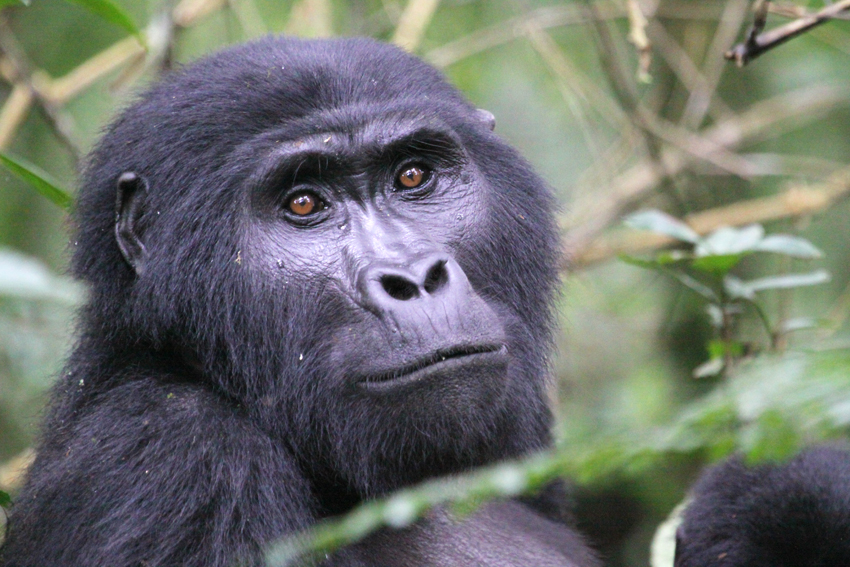Frequently Asked Questions about Kibale Forest National Park. The Primates Capital of the World – The location of Kibale Forest -Birding inside the Kibale National Park
Frequently Asked Questions about Kibale Forest. Discover here the most often asked questions about Kibale National Park. The pinnacle of habituated chimpanzees in Africa is Kibale National Park. Every day, chimpanzee trekking consists of two morning and afternoon stints. Kibale National Park has over 795 square kilometers of territory. Along with many other birds, this tropical forest supports the uncommon shoebill.
Queen Elizabeth National Park surrounds the southern portion of Kibale National Park, and a 180 km-long migratory strip runs alongside these protected areas. While some wild animals hunt in the forest, others, like elephants, duikers, Giant Forest pigs, and warthogs, cross into the forest to enjoy the flora. From Ishasha in the southern Queen Elizabeth National Park, this strip runs into Sebitoli Forest in Kibale.
Among the over 13 primate species listed above—Black and white colobus, olive baboons, Bushbaby, red-tailed monkeys, and grey-cheeked mangabey—Kibale National Park is also the hangout for them.
Issues Raised About Kibale National Park
The location of Kibale Forest is
Kibale National Park is located in western Uganda in East Africa. One of the largest populations of Primates in Uganda, Kibale is a most precious tropical forest and habitat. Particularly in the North and center sections around Fort Portal plateau, most of the park consists of forest cover.
The park is located 1590 meters above sea level. Among the many wild creatures found in the Kibale forest, including monkeys, forest elephants, duikers, gigantic forest pigs, a rich bird life, and warthogs, the variable altitude offered suitable homes. From the wet tropical forest atop Fort Portal Plateau to the dry tropical forest to the woodland and savannah along the rift valley level, the forest is composed of
Kibale National Park has different rainfall, mostly in the northern part, with around 1800mm. March through May and November are the wettest months in the park. From Ndali to Kasenda, Kibale National Park is a vista gold mine. Among the very remarkable vistas are those of Kyaninga Lake.
How To Spend Time In Kibale National Park
Chimpazee Trekking
The main activity in Kibale National Park is chimpanzee trekking. There are morning and afternoon chimpanzee hiking shifts two-wise. Although the chimpanzees could spot you before you locate them, you follow them with the ranger guide. Operating a spy network, they alert the remainder of the gang to your presence.
Another option is the Chimpanzee Habituation, wherein you accustom the largely wild chimpanzees in the forest to human presence. This is particularly true in the shoulder seasons, March through May or November, when visitor count is low. You wake early morning—between 0500 and 0630 hours—with researchers to see the chimpanzees de-nesting. Follow them till late evening, when nesting.
Like red-tailed monkeys, vervet monkeys, black and white colobus, grey-cheeked mangabey, olive baboons, bush babies, L’Hoest’s, and others, many more primates spend their day in the forest. Visiting Bigodi Swamp allows you to appreciate more of these amazing primates.
Other Activities Available at Kibale National Park
Birding inside the Kibale National Park
There is great birdlife in this tropical jungle, including numerous Albertine endemists. Rich environments like the marshy plants provide a secure refuge for aquatic birds like the shoebill. Along the main route from Kanyanchu Visitor Center to the bridge, the finest woodland birding is found.
Among the species you could find at Kibale National Park are Scaly Francolin, Grey-headed olive-back, Black-crowned Waxbills, Band lack, and White Mannikin.
Community walks at Bigodi Wetland Sanctuary.
On the edge of the park in Magombe Swamp, this community-based path is located. You have opportunities to see primates like black and white colobus, vervet monkeys, red-tailed monkeys, olive baboons, and others on this tour.
Other forest wild species that like this swamp-like bush include bucks, otters, mongoose, and sitatunga.
The woodland has an amazing array of 138 kinds of birds throughout the day. The boardwalk route and the observation platform clearly show them.
Kihingani Wetland Walking Path
You pass the Kihingani marsh on the outskirts of the Kibale National Park Sebitoli section. You may see some birds that remain in the Swamp all day.
Activities of Children in Kibale National Park | Frequently Asked Questions about Kibale Forest
Traveling with family, including young children under the age of fifteen, raises several issues about whether they will be part of the forest experiences. While youngsters below this have things to do in the park too, the age restriction for chimpanzee trekking is 15 years and above.
The youngsters spend around one to two hours learning about birds, flora, less hazardous tiny animals, and monkeys on an educational walk guided by their dedicated ranger. They have a firsthand understanding of the ecology and its inhabitants.
They work on various interesting projects like cyanotype, photography, batik creation, and pond dipping. Rest confident that the youngsters are provided for when you go chimpanzee trekking.
Where To Book Accommodation in Kibale National Park
Feeling the influence of the forest’s cool wind makes an overnight stay in Kibale National Park or outside Kibale National Park rather remarkable. There are many lodging venues ranging from Luxury to Moderate to Modest.
Among the hotels in Kibale National Park are Primates Lodge, Ndali Lodge, Kibale Safari Lodge, Kyaninga Lodge, Chimps Nest, guest house, Mountains of the Moon hotel, and Virika guest house.
Most of these establishments conduct complete board operations; those that do not run restaurant operations also.
How to get to Kibale National Park
By road
From Kampala city, Kibale National Park may be accessed by two routes.
From Kampala to Mubende, then Fort Portal
Kibale National Park’s northern access is this one. To reach Kanyanchu, one drives across 300km of asphalt from Fort Portal and then across 36 km of murram around four hours later. You might choose to hike chimpanzees in Kibale National Park and spend nights at Fort Portal.
From Kampala to Mbarara to Kamwenge
This path passes Queen Elizabeth National Park, then reaches Sebitori woodland camp, another tourist site for Kibale National Park.
One must use a transfer vehicle to Kibale National Park from Entebbe or Kajjansi Airstrip via Kasese Airstrip. These do daily trips in the morning and afternoon.
Charter flight plans are on request.
What Should One Bring for Kibale National Park Chimpanzee Trekking?
Two binoculars can help you to see the chimpanzees more clearly, particularly during the heavy rainy season when they eat from up the trees.
Energy snacks help you stay active as you seek the chimps.
Good lens cameras allow one to record events involving chimpanzees and forest dwellers that come into view.
Try not to take long pants and sleeved shirts in khaki, since army camouflage is banned from being worn in Uganda.
Comfortable on your skin, insect repellent protects you from bug bites. All day long, stinging insects from the bush prowls the park.
Comfortable enough to traverse the forest without sliding or being stabbed by sharp things, tracking boots are
Rainproof devices as tropical rain forecasts, might experience rain even outside of their season.
The ideal time to visit Kibale National Park | Frequently Asked Questions about Kibale Forest
Since the chimpanzees eat closer to the ground, Kibale National Park—a chimpanzee tracking site—is best visited in the dry months, June through September and December. One may perform chimpanzee trekking even in the rainy months of March to May or November; nevertheless, one can anticipate occasional rain showers throughout the search.
How Much Is Trekking for Chimpanzees? In the Kibale National Park
Every chimpanzee trekking permit costs international non-residents $300 per person, foreign residents $250, East African residents Ugsh 100,000 in Kibale National Park. Uganda Wildlife Authority issues these licenses.
How Long Is Trekking Among Chimpanzees in Kibale National Park?
Two daily chimpanzee trekking trips are carried out in Kibale National Park, morning and afternoon shifts.
Each group is permitted just six members, and depending on the state of the forest, chimpanzee trekking might last three to five hours. You follow the path the chimpanzees were seen on yesterday.
Once you find them, only one hour is given to let the chimpanzees go on eating. They have to eat free from intervention.
The degree of safety in Kibale National Park | Frequently Asked Questions about Kibale Forest
Being a woodland park, Kibale National Park raises issues about its safety. For all kinds of activities like chimpanzee trekking, birding, going on outdoor hikes, and more, Kibale is safe.
Visitors assemble in the visitor center (Kanyanchu or Sebitori) for a briefing before starting any activity. This aims to provide everybody with knowledge about the forest and its occupants, including chimpanzees, forest elephants, duikers, and so much more. Enter the forest without a ranger ever.
Staying near the rest of the party would be ideal so that you never get lost in the wilderness. Though he does not pull the whole party, the ranger guide moves at the slowest pace among the trekkers.
What Do Chimpanzees Eat?
Though it’s an unusual occurrence, particularly for a forest as abundant in flora as Kibale Forest, chimps are mostly vegetarian but may consume monkeys at times of great shortage and drought.
Please contact Katland Safaris to learn more about the frequently asked questions about Kibale National Park. Please kindly check our travel adviser page here. What others think about our service and what we do.
Booking gorilla trekking safaris in Uganda and Rwanda with Katland Safaris.
Katland Safaris organizes the best gorilla and wildlife safaris in East Africa. When it comes to gorilla trekking, we will book your gorilla trekking permits for Uganda`s Bwindi and Mgahinga gorilla national park and gorilla permits for Volcanoes National Park in Rwanda. Besides booking your gorilla permit, we will also put all other gorilla safari accessories, like transportation and accommodation, in one package to make your gorilla trekking safari a memorable adventure:
Your gorilla trekking safaris can be customized to meet your safari expectations and needs, and budget. The safari package can range from budget, mid-range, and luxury safaris.
Feel free to contact our team of excellent safari consultants to help you organize the best Africa gorilla safari ever.
Embark on an unforgettable Gorilla trekking and wildlife safari experience in Uganda and Rwanda.
WhatsApp us at +256705778866 to book your safari today!
Email us at info@katlandafricagorillasafaris.com for more information
Visit www.katlandafricagorillasafaris.com for exciting tour packages and itineraries


